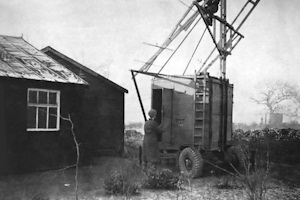Jodrell Bank celebrates 70th birthday
17 Dec 2015
A year of celebration will start this week as the world-famous Jodrell Bank Observatory celebrates its 70th birthday

Among the events to mark the anniversary are lectures, school events and a fundraising campaign.
Seventy years ago today Bernard Lovell, a physicist at the University, switched on some army surplus radar equipment in a muddy field in Cheshire, part of The University of Manchester’s Botany Department.
With permission to stay for just two weeks, he never left. And now Jodrell Bank Observatory is a world-renowned centre of radio astronomy research.
Tim O’ Brien Professor of Astrophysics, and Associate Director at Jodrell Bank, said: “After 70 years, Jodrell Bank remains at the cutting edge of scientific research. Work which will continue for decades to come, thanks to projects such as the Square Kilometre Array, the next great radio telescope, whose international headquarters is now at Jodrell Bank.”
"It is a real privilege to work at such a wonderful facility."
Professor Teresa Anderson, Director of the Jodrell Bank Discovery Centre, said: “Jodrell Bank holds a place in people’s hearts across the North West and beyond. It has become a major landmark in the Cheshire countryside and an icon of science & engineering. But it is also a landmark visitor destination, with educational programmes inspiring the next generation.”
After developing aircraft radar systems during the Second World War, Bernard Lovell returned to his position at Manchester, continuing his work on cosmic rays – high-speed particles from outer space. Background interference from the electric trams on Oxford Road compelled Lovell to seek a more secluded location for his work, which led him to Jodrell Bank in 1945, an outpost for the University’s Botany department. Here, Lovell used radar to investigate meteors and built the 218-foot Transit Telescope, which made many important discoveries, particular among them being the detection of radio noise from the Great Nebula in Andromeda – the first time that a known extragalactic radio source had been detected.
These ground-breaking developments in radio astronomy soon led Lovell to build the giant 250-foot radio telescope, which still bears his name. Since 1957, the Lovell Telescope has led the world in exploring the invisible universe using radiowaves. It also holds the distinction of being both the third largest steerable radio telescope in the world and a Grade 1 listed structure. This revolutionary new telescope helped create an awareness of a wider universe, and played a key role in the discovery and study of quasars, pulsars, gravitational lenses and many other phenomena. It also tracked the early space missions, including the Russian rocket, which put the first artificial Earth satellite, Sputnik, into orbit in 1957, at the dawn of the Space Age.
Today, Jodrell Bank remains one of the most important scientific landmarks in the world and is on the UK shortlist for UNESCO World Heritage Site Status.
